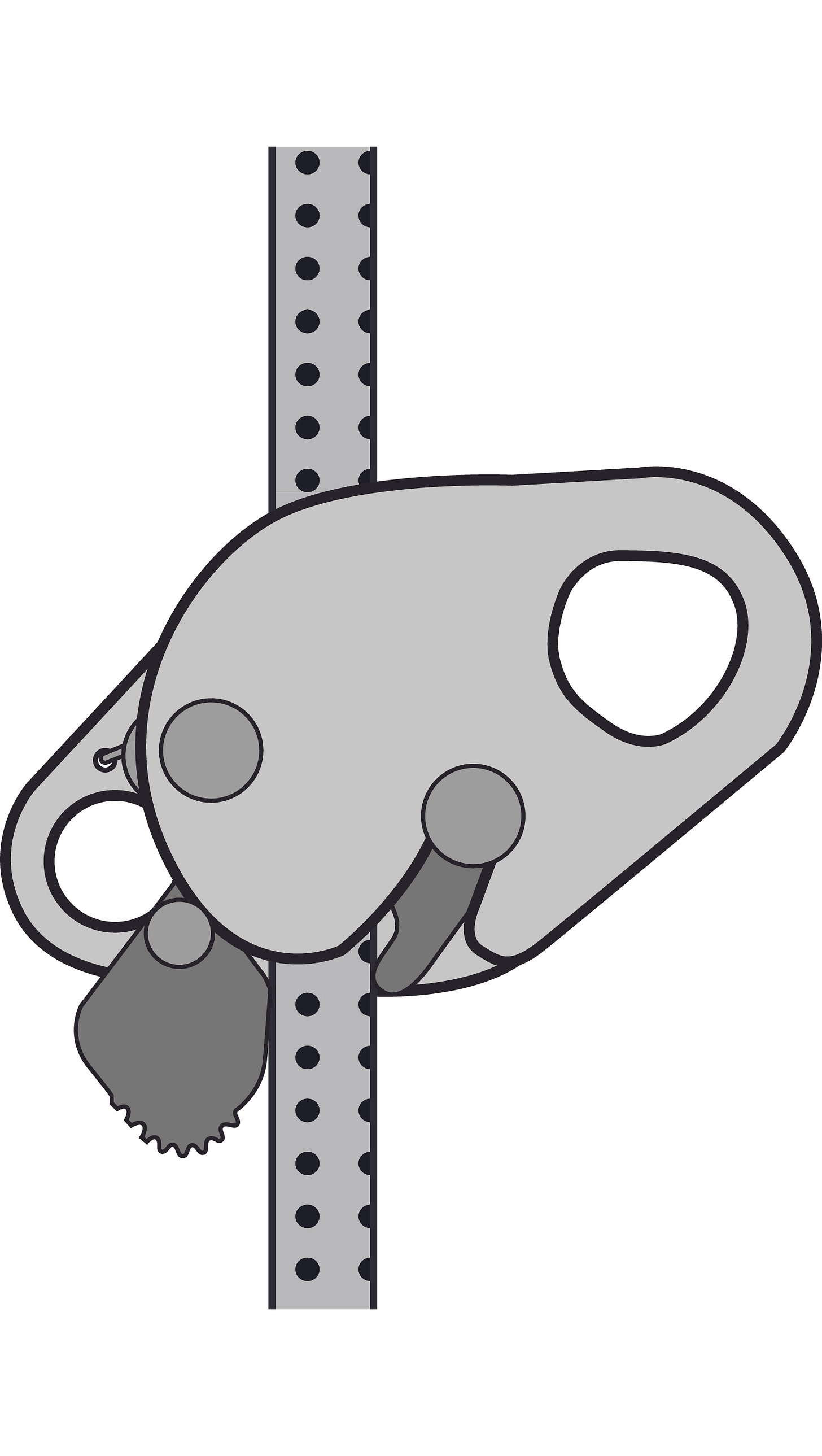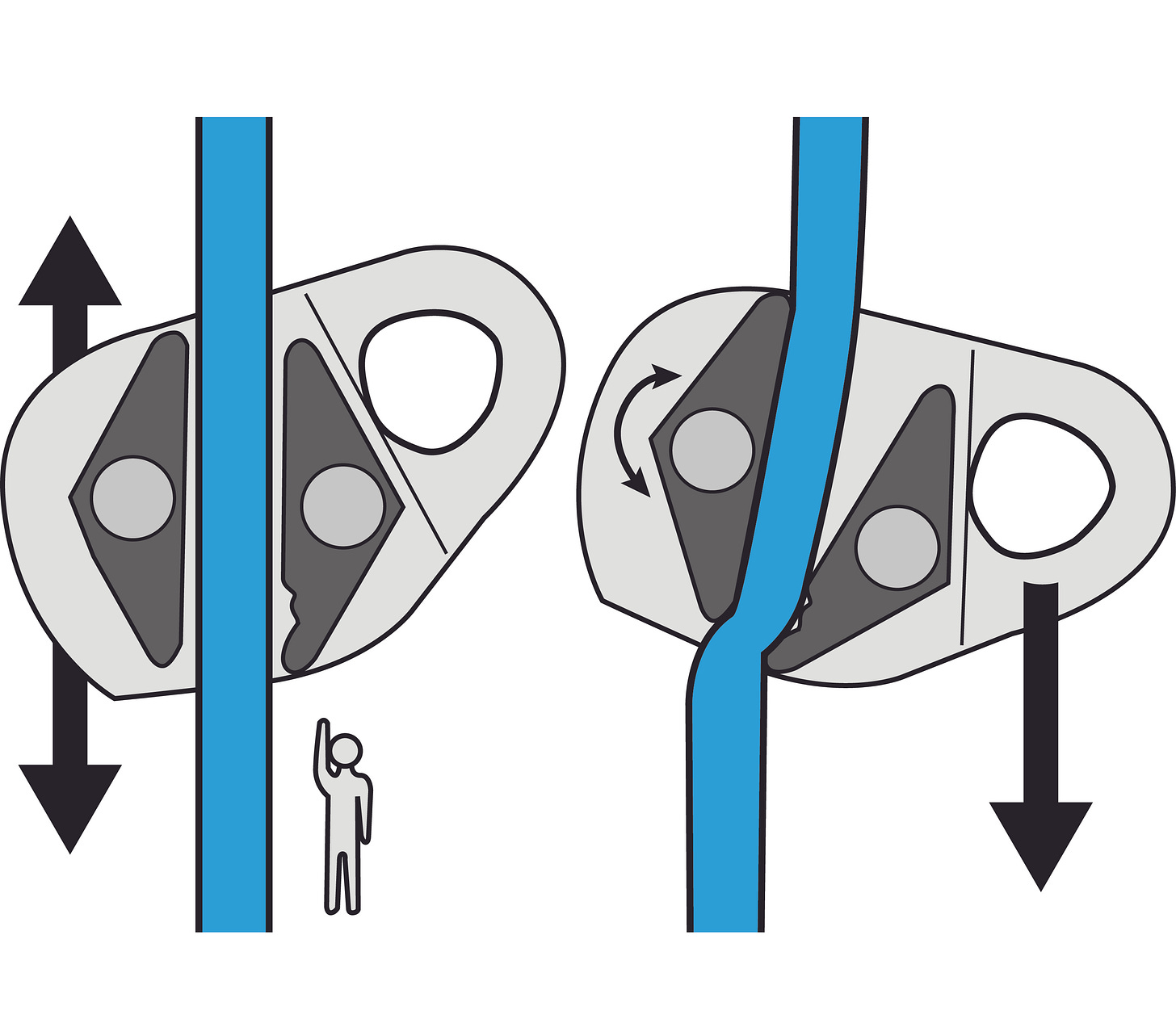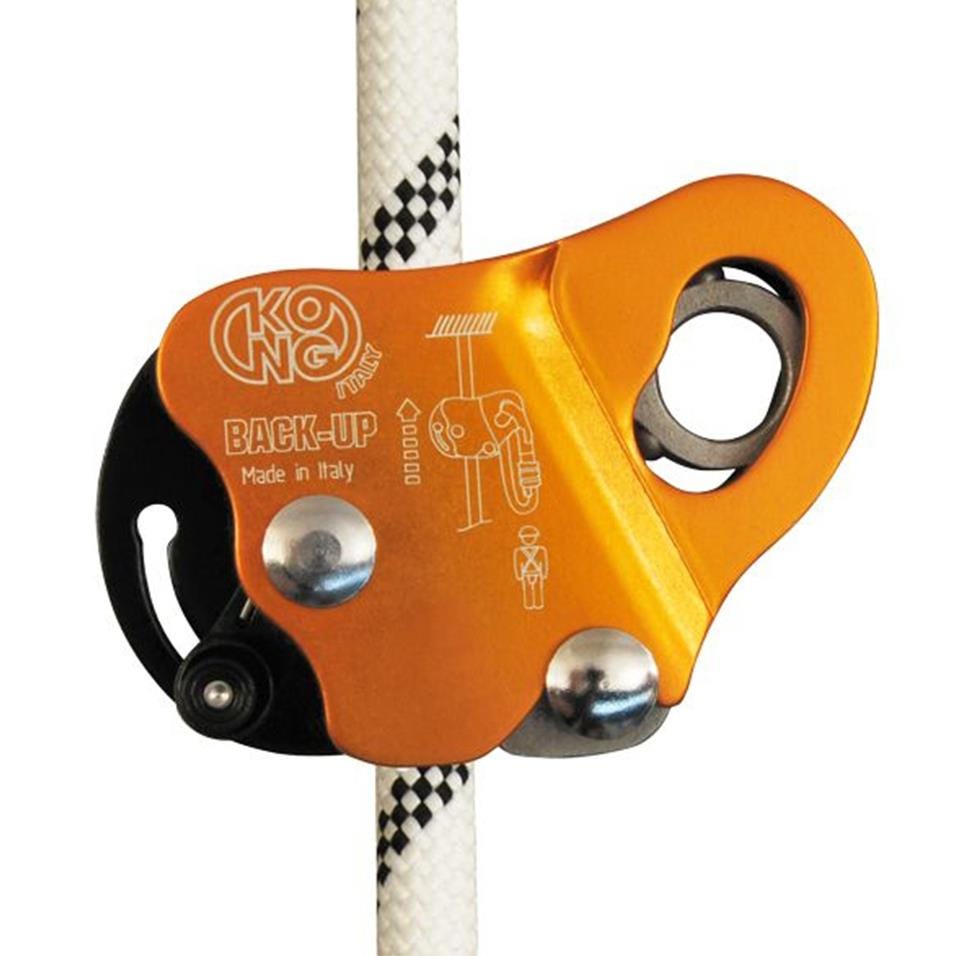Rope Soloing Devices part 2
In this second part of my preview of On the Line, I move on from eccentric rope clamps, coving the less well known rocker arm device.
Rocker Arm
Invented by Russian climber Victor Kozlov in 1975, this design and mechanism radically departed from Western designed eccentric rope clamps established by Petzl and Jumar, yet offered several advantages over conventional rope clamps.
Manufactured by Ural-Alp, these devices appeared in the West in the 90s, as the Soviet Union broke apart, with the mechanism being adopted by several Western manufacturers. The Welsh hardware manufacturer ISC produced a copy called the "Rocker", making them also for companies like Troll, Yates and numerous industrial rope access brands, that being their intended market.
The mechanism revolves around two components, the rocker and the anvil, both secured within two alloy side plates. The rocker rotates around a high strength stainless steel pin/axel, but is blocked from full rotation due to the anvil, which is fixed in place.
Rocker and anvil are milled from either stainless steel for heavy duty use, or alloy for low weight.
The rope is inserted by opening up one side plate and placing the rope between the rocker and the anvil. The plate is then closed and locked shut with either sprung button, or by clipping in a locking karabiner, meaning once locked shut, the rope cannot escape.
The rocker action works in the following way:
When the frame is weighted, the rocker is forced upwards, causing the bottom of the rocker to compress the rope. When unweighted the rope is free to move within the device, meaning the device is bi-directional. This ability to move up and down a rope without assistance made this design an early replacement for the Petzl Shunt.
Unlike an eccentric device, which will begin to damage the rope at around 4 kN, the lack of teeth or spikes on the rocker means the rope will eventually slip at approximately the same load, locking again once the load has dissipated.
Example
DMM Buddy, Ural Alp Basic, Camp Lift, Camp Goblin, Kong Back-Up, Grand Wall uAscend, ISC Rocker, ISC RED, Yates Rocker, Troll Rocker, SAR Rocker.
Failure modes and effects
The mechanism must be allowed to pivot in order to grab the rope, and so will fail if blocked from doing so. This could can accure in several ways, including:
The device being panic grabbed before it has had chance to lock.
The device being held between the body and the rock, or by a body part (arm pit, between the legs).
If the rope is grabbed above the device, this may also stop the device from grabbing.
If the spring in the rocker becomes ineffective due to wear and tear, there may not be enough pressure to make the initial force on the rocker engage. This could result in the device failing to grab the rope.
Most of the rocker devices on the market are designed for industrial rope access and have been designed to work on, and tested with, ropes of 10.5 mm or larger. This means that unless specified if using a rocker device on a sub-optimal rope can produce sub-optimal results.
If the counter-weight is greater than 1 kilogram, there is a risk with some rocker devices will fail to engage, as there will not be enough flexibility in the rope to engage the rocker, leading to a ground fall.
The chance of such a failure depends on several factors, including the power of the rocker spring, with a strong spring priming the rocker to lock more effectively than a weak spring. Unfortunately, a strong spring will not slide as easily as a weak spring, and so requires a heavier counter-weight.
Due to the rocker mechanism being unconventional and bi-directional, there is a great risk of pilot error, with the device being placed upside-down, and appearing to work, but failing when fully loaded.
When employed as a back-up on a back-up rope, the lanyard should be both dynamic and kept under 60 cm in order to limit the impact on the rocker.
Suitability for TRS
Pros
Self Feeding.
Bi-directional.
Slips at 4 kN rather than damaging rope.
Miniumum of moving parts.
Less effected by icy or dirty ropes.
Compact and lightweight.
Low Cost.
Cons
Device can be disabled if panic grabbed.
Panic grabbing the live climbing line can block the rocker from functioning.
Can fail if blocked/depressed from above.
Less intuitive than other devices (easily inverted).
Effectiveness of device is dependent on spring strength.
Requires correct counterweight, neither too light or too heavy (ideally around 1 kg).
Requires maintenance of spring and rocker.
Must be used with correct rope diameter, generally 10.5 mm or larger (not 9.2 mm sport climbing ropes).
Conclusion & Personal reflections
If you viewed an eccentric device like a Petzl Croll as the hardware equivalent of fish and chips, a rocker style device like a Camp Goblin would be a Japanese puffer fish, a great delicacy in the hands of someone who knows what they’re doing, deadly in the hands of the unaware. If you read the pros and cons above you will see that the cons pretty much right out the pros, which makes rocker style devices one of the most dangerous to use for TRS, well, if you think it’s a fish and chips device.
A rocker device is not a device for novice climbers, no matter how much people direct you towards them on forums.
One issue with rocker devices, is that someone who’s already done their apprenticeship in TRS using an eccentric device, and has grasped all the basics, will assume the failure modes of a Goblin is the same as a Croll; when it isn’t. If they grab the rope above the device, or the device, or they stack it below an upper device that fails and slams down on the Goblin, well, that’s a big helping of puffer fish pie to swallow.
What this translates to is you need to set aside what you know about eccentric devices, and learn how to use rockers from the ground up (literally).
The pros of the rocker design, primarily it’s bi-directional nature, make it fantastic for climbing up and down, and around, on a route. But it’s lack of total dependency means I would never trust any rocker device on it’s own, but only when used with a secondary device. This could be a second rocker on a two rope system, or stacked above an eccentric device (this negates its bi-directional properties, but that’s the price of 100% security).





Hi Andy,
Not expecting a reply but was just curious on your opinions of the suitability of a rocker for lead rope solo. After reading Rob Thornton's blog post http://soloalliance.blogspot.com/2011/12/self-belay-with-troll-rocker.html I was tempted due to the cheaper cost and seeming simplicity.
I would be using the system with a backup but wanted to know if this was something you would trust.
Thanks
Hi Andy,
As usual, interesting article on something I knew nothing about. Saw the following which looks like similar mechanism. But, £24??!!?? Too good to be true? https://www.ebay.co.uk/itm/373602239854?mkcid=16&mkevt=1&mkrid=711-127632-2357-0&ssspo=FiFjXau-RZm&sssrc=2349624&ssuid=mb5c6Hx9S3W&var=642610115224&widget_ver=artemis&media=COPY